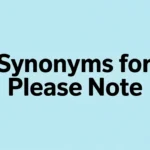Sometimes, “FYI” feels too formal, too casual, or just overused. Whether you’re sending an email, writing a report, or texting a friend, having a variety of ways to say “For Your Information” can make your communication feel fresh, engaging, and appropriate for the situation. Language is all about nuance, and choosing the right words can set the right tone. Other Ways to Say “FYI”.
If you’re in a business setting, you might want something more polished. If you’re chatting with a friend, a playful or casual alternative works better. The right phrase can ensure your message is received as intended—whether it’s serious, informative, or friendly.
This article explores different ways to say “FYI” in various contexts. We’ll cover professional alternatives, casual expressions, and even creative ways to pass along information. By the end, you’ll have plenty of options to keep your language varied and engaging.
Just a Quick Heads-Up
“Just a quick heads-up” is a friendly and conversational way to share information. This phrase works well in both personal and professional settings. It feels casual but still maintains a level of professionalism when used in emails or workplace conversations.
For example, you might say, “Just a quick heads-up, the meeting has been rescheduled for 2 PM.” This ensures the recipient knows the information is important without making it seem overly formal.
The phrase is also useful when sharing updates, reminders, or important details that someone should be aware of. It softens the message and makes it feel more like a friendly nudge rather than a command. When used in written communication, adding a smiley face or a polite closing can make the message feel even more approachable.
Read More: Other Ways to Ask “Who Is This?” Over Text
For Your Reference
“For your reference” is a professional alternative to “FYI” that is commonly used in emails and reports. It’s particularly useful when providing additional details, documents, or resources that the recipient might need.
For example, if you’re sharing a document, you could say, “For your reference, I’ve attached the updated report.” This phrase signals that the information is useful but does not necessarily require immediate action.
It’s often used in workplaces to provide background information or supporting documents. Whether you’re responding to a request or offering helpful details, “for your reference” keeps the message clear and professional.
This phrase also works well in customer service, research, or any field where information needs to be shared efficiently. It strikes a balance between formality and helpfulness, making it a go-to choice in business communication.
Just So You Know
“Just so you know” is a casual and friendly way to share information. It works well in conversations where you want to give someone a heads-up without sounding too formal.
For example, you might say, “Just so you know, I’ll be out of town next weekend.” This phrase is often used when sharing personal updates, reminders, or general information that someone might find useful.
Unlike “FYI,” which can sometimes sound abrupt, “just so you know” adds a personal touch. It makes the message feel more thoughtful and considerate. This phrase is great for text messages, casual emails, and face-to-face conversations.
It’s also useful when sharing opinions or giving someone insight into a situation. If you want to keep things light and friendly while still getting your point across, this is a great alternative to “FYI.”
Please Be Advised
“Please be advised” is a formal alternative to “FYI” that is often used in official communications. It is commonly seen in emails, legal documents, and company announcements.
For example, a company might send an email stating, “Please be advised that our office will be closed on Friday for maintenance.” This phrase signals that the information is important and should be noted.
Unlike casual phrases, “please be advised” carries a sense of authority and professionalism. It is useful when sharing policy changes, official statements, or instructions that must be followed.
This phrase is particularly effective in legal and business settings where clarity and formality are key. It ensures that the recipient understands the seriousness of the information being shared. However, it is best to avoid this phrase in casual or personal conversations, as it may come across as overly stiff or impersonal.
In Case You Didn’t Know
“In case you didn’t know” is an informal and engaging way to share information. It works well in casual conversations, social media posts, or friendly emails.
For example, you might say, “In case you didn’t know, there’s a big sale happening this weekend!” This phrase adds a sense of excitement or discovery to the message.
Unlike “FYI,” which is neutral, “in case you didn’t know” often carries a more playful or conversational tone. It’s a great way to introduce interesting facts, fun updates, or useful tips.
However, this phrase should be used carefully in professional settings. It may sound too informal or even slightly condescending if not used appropriately. But in the right context, it can make your message feel more engaging and relatable.
For Your Awareness
“For your awareness” is a professional and neutral way to share information. It is commonly used in workplace communication, especially when providing updates or alerts that may not require immediate action.
For example, an email might state, “For your awareness, we are implementing new security protocols starting next week.” This phrase ensures that the recipient understands that the information is important but does not necessarily require a response.
Unlike “FYI,” which can sometimes seem abrupt, “for your awareness” sounds more polished and thoughtful. It is particularly useful in corporate settings, where clarity and professionalism are essential.
This phrase works well when addressing colleagues, supervisors, or external partners. It helps maintain a professional tone while keeping the recipient informed. However, in casual conversations, it may feel too formal. If you’re communicating with friends or family, a more relaxed alternative like “just so you know” may be a better fit.
A Quick Note
“A quick note” is a friendly and easygoing way to introduce information. It is commonly used in casual emails, workplace messages, and social conversations.
For example, you might start an email with, “A quick note about the upcoming meeting—please bring your project updates.” This phrase signals that the message is brief and to the point.
It is especially useful when you want to share something important without overwhelming the recipient with too much detail. The phrase makes the message feel more conversational and less formal.
Using “a quick note” helps soften the tone of an email or text, making it feel more approachable. It works well for professional and personal interactions where you want to maintain a light yet informative style.
However, in highly formal settings, this phrase might be too casual. If you’re addressing executives or writing official documentation, a more polished phrase like “please be advised” might be better.
Thought You Should Know
“Thought you should know” is an informal and personal way to share information. It adds a thoughtful touch, making it perfect for conversations with colleagues, friends, or family members.
For example, you might say, “Thought you should know that the deadline for submissions has been moved to Friday.” This phrase makes the message feel like a helpful update rather than an abrupt announcement.
This phrase is useful when passing along useful or surprising information that the recipient may not have been aware of. It adds warmth and a personal touch that “FYI” often lacks.
It works well in both personal and professional settings, depending on the tone of the conversation. In the workplace, it can be used for friendly communication with coworkers. However, for formal business emails, “for your reference” or “please be advised” may be more appropriate.
Overall, “thought you should know” is a great way to keep communication engaging and approachable.
Important Update
“Important update” is a strong and direct way to introduce information. This phrase is commonly used in business emails, newsletters, and announcements to highlight key details.
For example, a company might send a message saying, “Important update: Our office will be relocating to a new building next month.” This immediately grabs attention and signals that the information is significant.
Using “important update” helps emphasize urgency and ensures that the recipient pays attention to the message. It is especially effective when sharing changes in policies, schedules, or major decisions.
This phrase works well in both professional and public communication. It adds weight to your message and makes it clear that the information should not be ignored.
However, it should be used carefully—if overused, it can lose its impact. If the update is minor, a softer phrase like “just a quick heads-up” or “for your awareness” may be more appropriate.
Here’s Something to Keep in Mind
“Here’s something to keep in mind” is a thoughtful and engaging way to introduce important information. It works well in conversations where you want to offer advice, guidance, or relevant details.
For example, you might say, “Here’s something to keep in mind: The venue for the event has changed to the downtown conference center.” This phrase gently encourages the recipient to take note of the information.
Unlike “FYI,” which can sound abrupt, “here’s something to keep in mind” feels more natural and conversational. It’s great for professional emails, friendly reminders, or even social media posts.
This phrase is particularly useful when offering suggestions or helpful insights. It frames the information as something valuable rather than just a casual update.
It works in both formal and informal settings, making it a versatile choice for various types of communication. Whether you’re at work or chatting with friends, this phrase ensures your message is well received.
Just Sharing This with You
“Just sharing this with you” is a friendly and neutral way to pass along information. This phrase is particularly useful in emails or messages where you want to provide details without pressuring the recipient to respond.
For example, you might write, “Just sharing this with you in case it’s helpful for your project.” This lets the recipient know that the information is relevant but does not demand immediate action.
This phrase is useful in professional and personal settings, making it a great alternative to the sometimes impersonal “FYI.” It conveys a sense of helpfulness and consideration, which can make your message feel more engaging.
However, it should be used in appropriate contexts. In formal business communication, a phrase like “for your reference” or “please be advised” may be a better choice. But when you want to keep things conversational and light, “just sharing this with you” works perfectly.
Something You Might Find Useful
“Something you might find useful” is a polite and engaging way to introduce helpful information. It encourages the recipient to take a look without feeling pressured.
For example, you might say, “Here’s something you might find useful—a new tool for organizing your workflow.” This phrase makes the information feel valuable and worth checking out.
This alternative is particularly effective when sharing recommendations, resources, or insights. It creates a sense of curiosity and makes the recipient more likely to pay attention.
In professional emails, this phrase works well when suggesting solutions or offering guidance. It adds a touch of thoughtfulness to your message, making it feel more personal.
However, it may not be suitable for urgent or serious updates. If the information is critical, a phrase like “important update” or “please be advised” would be more appropriate.
Quick Reminder
“Quick reminder” is a straightforward and effective way to pass along important details. It works well in situations where the recipient may need a gentle nudge to remember something.
For example, you could write, “Quick reminder: The report is due by 5 PM today.” This ensures that the information is noted without being too forceful.
This phrase is especially useful in workplace communication, where deadlines, meetings, and tasks are common. It helps keep people informed without sounding too formal or demanding.
Unlike “FYI,” which can sometimes feel vague, “quick reminder” clearly signals that the information is something to keep in mind. It’s a great way to prompt action without being intrusive.
While this phrase is effective, it should be used sparingly. Overusing reminders may make them feel less important. When sharing general information rather than a task-specific update, a phrase like “just so you know” might be a better fit.
In Case This Helps
“In case this helps” is a thoughtful and supportive way to share information. It suggests that the details may be useful but does not impose any obligation on the recipient.
For example, you might write, “In case this helps, here’s a guide on how to improve your presentation skills.” This phrase makes the information feel like a friendly suggestion rather than a directive.
This alternative works well in professional and personal settings. It is particularly useful when offering advice, resources, or insights that could benefit the recipient.
Unlike “FYI,” which can sometimes feel impersonal, “in case this helps” adds warmth and a sense of consideration. It shows that you are thinking about the recipient’s needs and want to provide value.
This phrase is ideal for collaboration and teamwork, where sharing helpful information is key. It keeps communication positive and engaging, making it a great choice for emails and conversations.
Here’s an Update
“Here’s an update” is a clear and direct way to introduce new information. It works well in situations where you need to keep someone informed about recent changes or developments.
For example, a manager might say, “Here’s an update on the project timeline: We’re moving the deadline to next Friday.” This phrase ensures that the recipient understands that the information is current and relevant.
This alternative is particularly useful in professional communication, especially when sharing progress reports, policy changes, or business news. It signals that the details are fresh and should be noted.
Unlike “FYI,” which can sometimes be vague, “here’s an update” clarifies that the information is new and important. It keeps communication clear and professional while maintaining a friendly tone.
This phrase is great for workplace emails, team meetings, and business announcements. It ensures that your message is received as informative and timely.
Noteworthy Information
“Noteworthy information” is a polished and professional way to introduce important details. It works well in formal emails, reports, and business communications.
For example, you might write, “This is some noteworthy information regarding the upcoming product launch.” This phrase ensures that the recipient understands that the details are significant.
This alternative is particularly useful when discussing key insights, company updates, or critical announcements. It adds a sense of importance without sounding too forceful.
Unlike “FYI,” which is often neutral, “noteworthy information” emphasizes that the recipient should pay attention. It helps create a sense of priority in your message.
This phrase is ideal for professional settings where clarity and formality are essential. It keeps your communication professional while ensuring that important details are properly highlighted.
Letting You Know
“Letting you know” is a casual and friendly way to introduce information. It works well in emails, text messages, and face-to-face conversations.
For example, you might say, “Just letting you know that we’ll be working remotely tomorrow.” This phrase makes the message feel natural and conversational.
This alternative is great for informal settings where you want to pass along details without sounding too official. It adds a personal touch, making communication more engaging.
Unlike “FYI,” which can sometimes seem abrupt, “letting you know” softens the message. It makes it clear that you are sharing information in a thoughtful way.
This phrase is useful in both personal and professional settings. It works best when keeping colleagues, friends, or family informed about plans, schedules, or updates.
Here’s a Heads-Up
“Here’s a heads-up” is a friendly and engaging way to introduce information. It is often used in casual conversations and workplace communication.
For example, you might write, “Here’s a heads-up: The parking lot will be closed for maintenance tomorrow.” This phrase helps the recipient prepare for the information being shared.
This alternative is particularly useful when giving warnings, reminders, or early notices about changes. It keeps communication clear while maintaining a relaxed tone.
Unlike “FYI,” which can feel neutral or detached, “here’s a heads-up” adds a sense of consideration. It makes your message feel more personal and engaging.
This phrase is great for workplace emails, friendly conversations, and team updates. It ensures that your information is received in a way that feels natural and helpful.
This May Be of Interest
“This may be of interest” is a polite and professional way to introduce relevant information. It works well when sharing news, research, or recommendations.
For example, you might say, “This may be of interest: A new study on productivity trends in remote work.” This phrase encourages the recipient to engage with the information.
This alternative is particularly useful when sharing articles, reports, or industry insights. It makes the information feel valuable without forcing the recipient to act on it.
Unlike “FYI,” which is neutral, “this may be of interest” adds a sense of curiosity. It invites the recipient to explore the details without pressure.
This phrase is great for networking, professional emails, and knowledge sharing. It keeps communication professional while making the information feel engaging and relevant.
Passing This Along
“Passing this along” is a casual and helpful way to share information. It works well in team communication, workplace emails, and informal conversations.
For example, you might say, “Passing this along in case you need it—here’s a guide to the new software.” This phrase makes the information feel like a useful resource rather than a demand.
This alternative is particularly useful when forwarding messages, documents, or relevant updates. It signals that the details may be helpful without implying urgency.
Unlike “FYI,” which can feel impersonal, “passing this along” adds a sense of thoughtfulness. It makes the recipient feel that the information was selected with their needs in mind.
This phrase is great for collaboration and teamwork. It ensures that communication remains smooth and supportive, making it a valuable alternative to “FYI.”
Would you like any refinements or additional alternatives?
Conclusion
There are many ways to say “FYI,” depending on the tone and formality of your message. Whether you need a casual, professional, or creative alternative, choosing the right phrase can enhance your communication.
For workplace emails, phrases like “for your reference” or “please be advised” add professionalism. If you want a friendly approach, “just a quick heads-up” or “just so you know” can make your message feel more personal.
Language shapes how people receive information. Using a variety of expressions instead of the standard “FYI” can help your messages feel more engaging, clear, and appropriate for different situations.
Next time you need to pass along information, try switching things up with these alternatives. You’ll keep your communication fresh, effective, and tailored to your audience.

Christopher Miller is a language expert at WordSeekerz.com, helping readers master English grammar, synonyms, and vocabulary with ease. Explore more at WordSeekerz.com!










